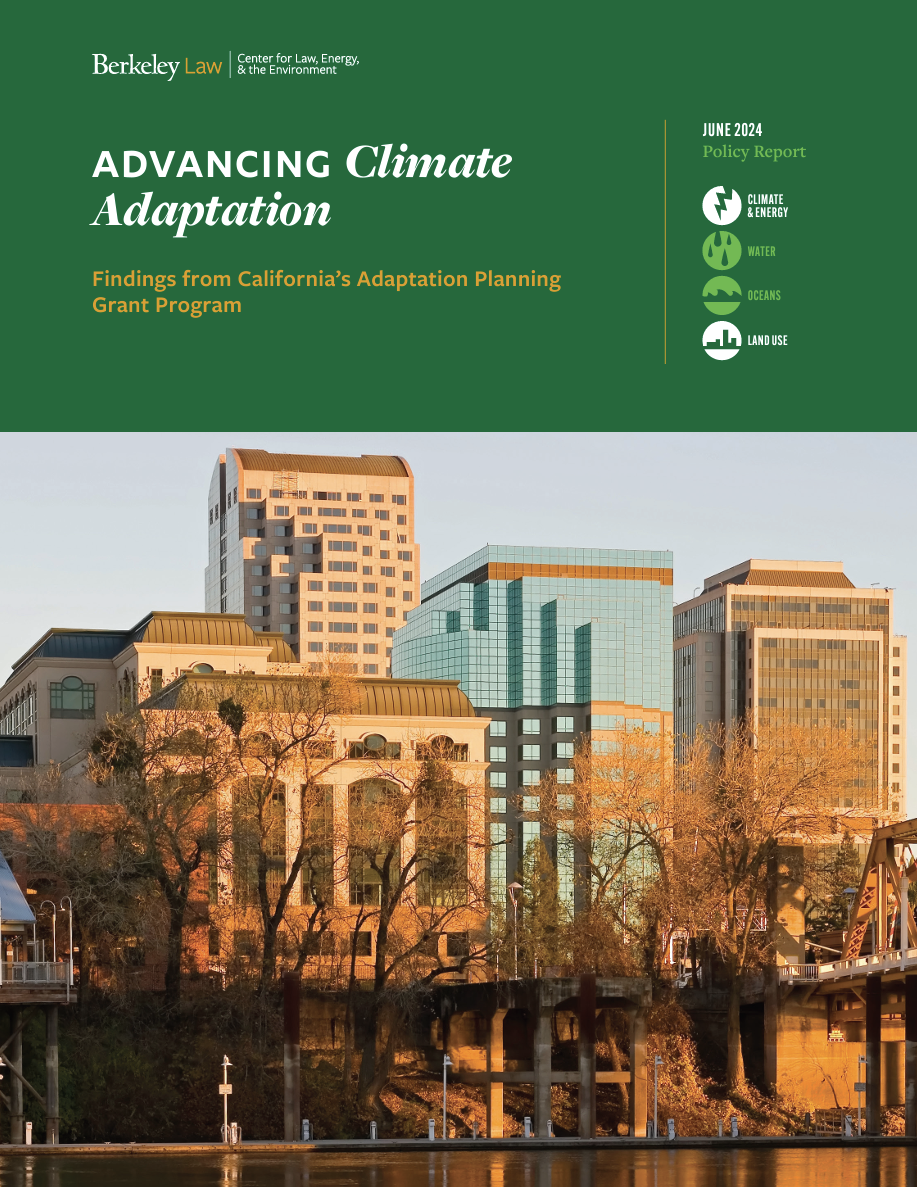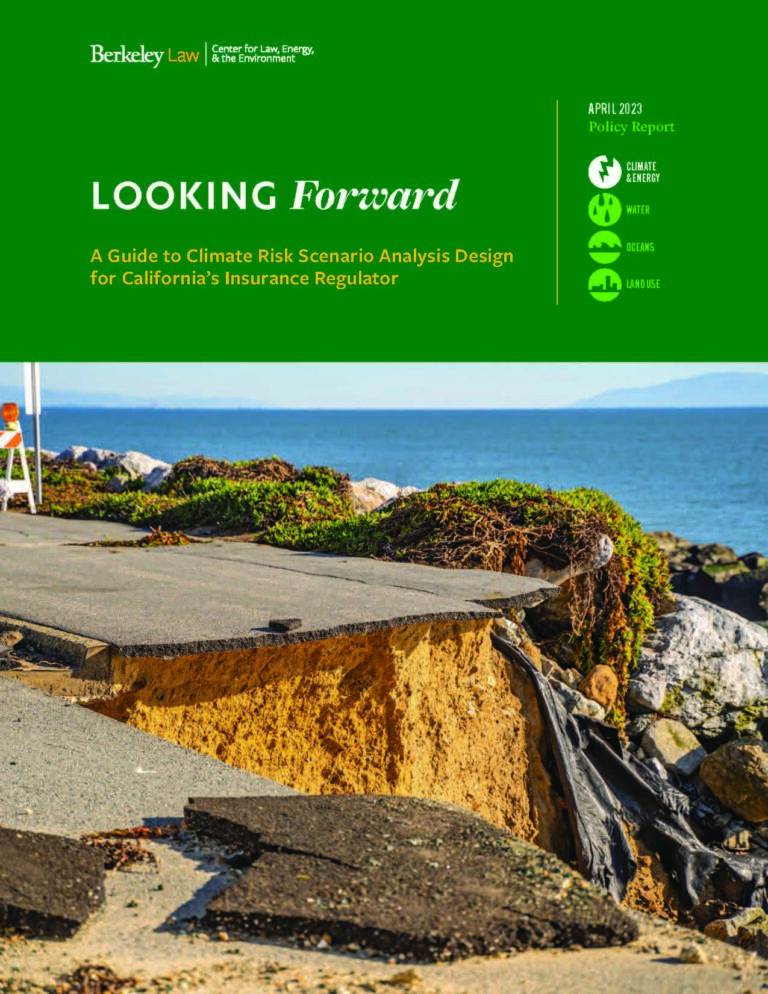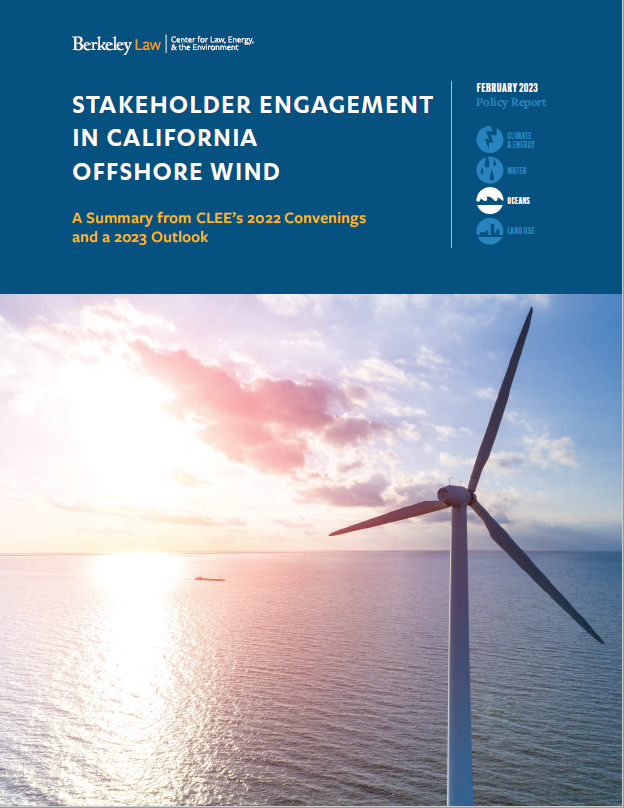The Center for Law, Energy & the Environment (CLEE) believes solving our most pressing environmental challenges requires actionable research, training, and engagement to accelerate the implementation of solutions.
Our Mission:
CLEE tackles climate change and other environmental challenges at the local to global scale through the development and implementation of equitable and effective legal and policy solutions. Our expert staff leverages the world’s leading public research university to engage community leaders, government, business, and other stakeholders; to lead timely and practical research initiatives; and to train leaders to take action on our most pressing environmental problems.
Our Values:
- Pragmatism: CLEE focuses on answering “how” questions and implementing timely and practical climate and environmental solutions
- Collaboration: CLEE convenes policymakers, stakeholders, and other interested parties to tackle complex problems
- Integration: CLEE builds expert multidisciplinary teams to solve problems
- Equity: CLEE is committed to representing and including diverse perspectives to design and implement equitable solutions
- Experience: CLEE’s experienced team of government leaders and experts brings invaluable practical knowledge to our work
In the News
Environmental Attorneys See Windfall After Biden Climate Law
(08/12/2024)Topics: Environmental Law Topic
Bears, Fish, and Wolves’ New Predator: the Supreme Court?
(07/24/2024)Topics: Environmental Law Topic
Recent Publications
A record of all CLEE reports is available here.
Fueling & Financing: Addressing the Urgent Challenges Facing Electric Heavy-Duty Vehicle Deployment
August 2024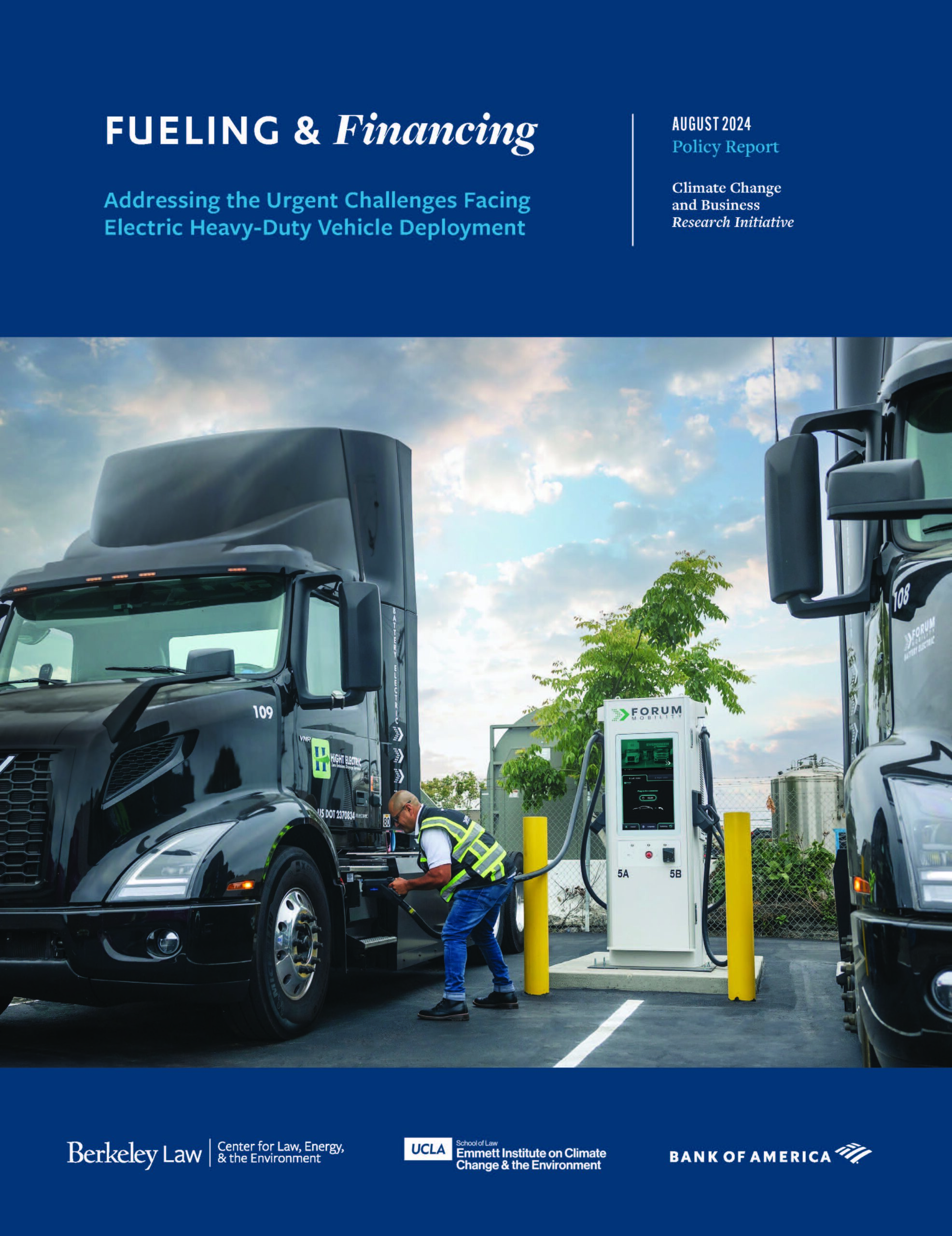
Heavy duty vehicles, such as large semi-trucks and buses, disproportionately contribute to harmful air pollution, particularly in low-income and disadvantaged communities. They also emit significant greenhouse gases, exacerbating climate change. Fortunately, zero-emission electric versions of these vehicles are on the road today and increasingly available. However, the infrastructure required to support these vehicles is immense. The California Energy Commission estimates that by 2030, the state will need 114,500 chargers to support the anticipated 155,000 medium- and heavy-duty electric trucks and buses.
To address these dual needs of infrastructure and financing, UC Berkeley Law’s Center for Law, Energy and the Environment (CLEE) and the UCLA Law Emmett Institute on Climate Change and the Environment convened experts and stakeholders to help identify the most pressing barriers both to deploying more charging infrastructure and to unlocking more private financing for both electric vehicles and the infrastructure on which they rely, as well as the solutions to overcome those barriers.
Read the report: Fueling & Financing: Addressing the Urgent Challenges Facing Electric Heavy-Duty Vehicle Deployment.
Policy Strategies to Promote Equitable EV Charging Access for Multifamily Housing Residents
August 2024 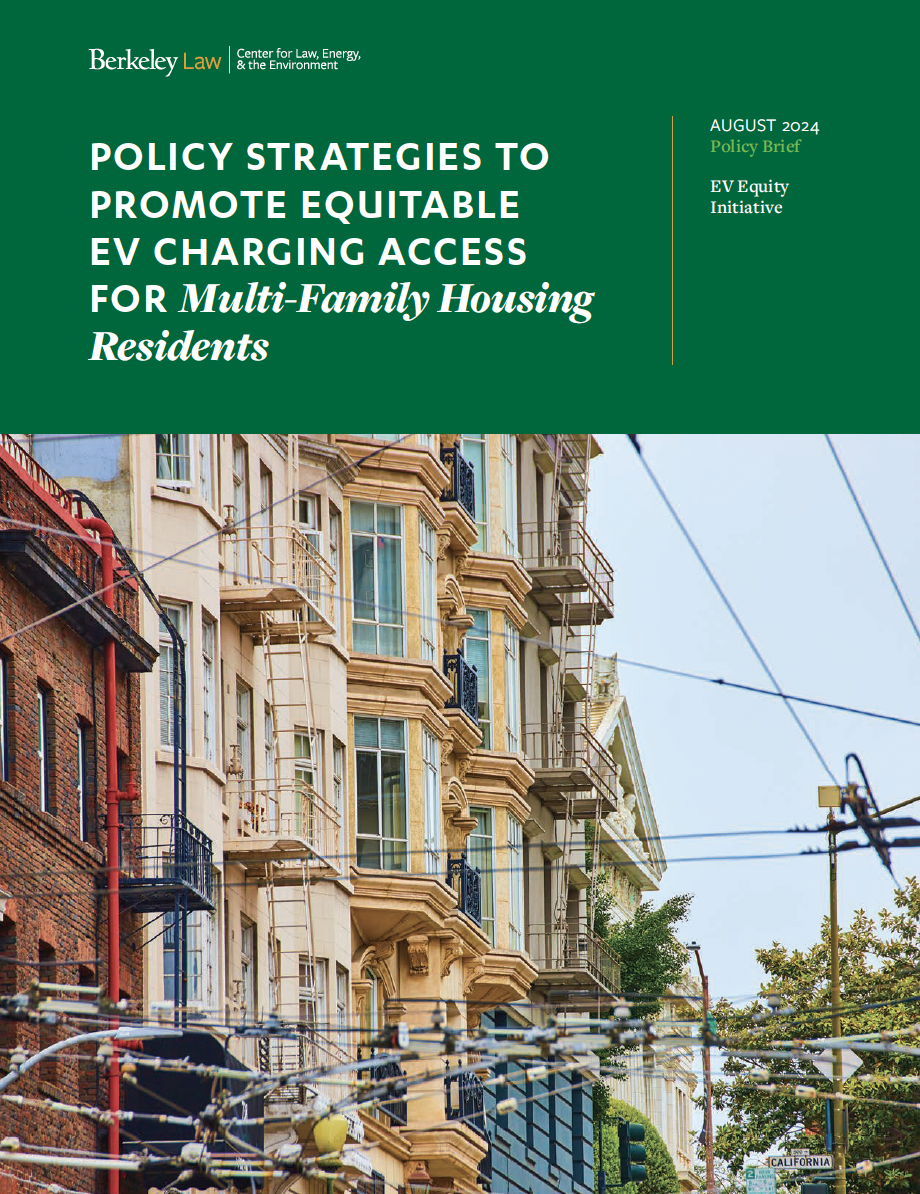
The rapidly approaching electric vehicle (EV) transition that California and 12 other states have committed to enact over the coming decade mounts pressure on state and local governments to deliver millions of new EV chargers across various location types. Homes constitute the core of a convenient and reliable charging network, and EV charging infrastructure in multifamily housing and multi-unit dwellings (MUDs) in particular, will serve a vital role in ensuring an equitable clean mobility transition.
The current lack of electric vehicle charging at MUDs limits the ability of their residents – particularly in lower-income and dense urban communities – to access the health and financial benefits of this clean technology. Our new report, informed by interviews with program officials and multifamily residential charging experts, draws from city programs and existing case studies to identify equity-oriented solutions to key MUD charging barriers.
Read the report: Policy Strategies to Promote Equitable EV Charging Access for Multifamily Housing Residents
Advancing Climate Adaptation: Findings from California’s Adaptation Planning Grant Program
June 2024
Building resilience to climate risks requires investment in adaptation, or a series of actions intended to anticipate, mitigate, and adjust to the challenges posed by warming conditions. Climate adaptation is crucial to building equitable resilience and safeguarding the state’s economy, environment, and public health.
The Integrated Climate Adaptation and Resiliency Program (ICARP) at the Governor’s Office of Planning and Research (OPR) administers the Adaptation Planning Grant Program (APGP). APGP provides funding to address local, regional, and tribal planning needs, equips communities with the resources to identify climate resilience priorities, and supports the development of planning-to-implementation project pathways across the state.
CLEE’s new report provides an initial assessment of the first round of APGP, including a review of adaptation funding literature, a landscape analysis of State programs facilitating local and regional adaptation actions, an analysis of program engagement and award data, and interviews with the 14 program grantees, as well as four grantee case studies.
Read the report: Advancing Climate Adaptation Capacity: Findings from California’s Adaptation Planning Grant Program
May 2024 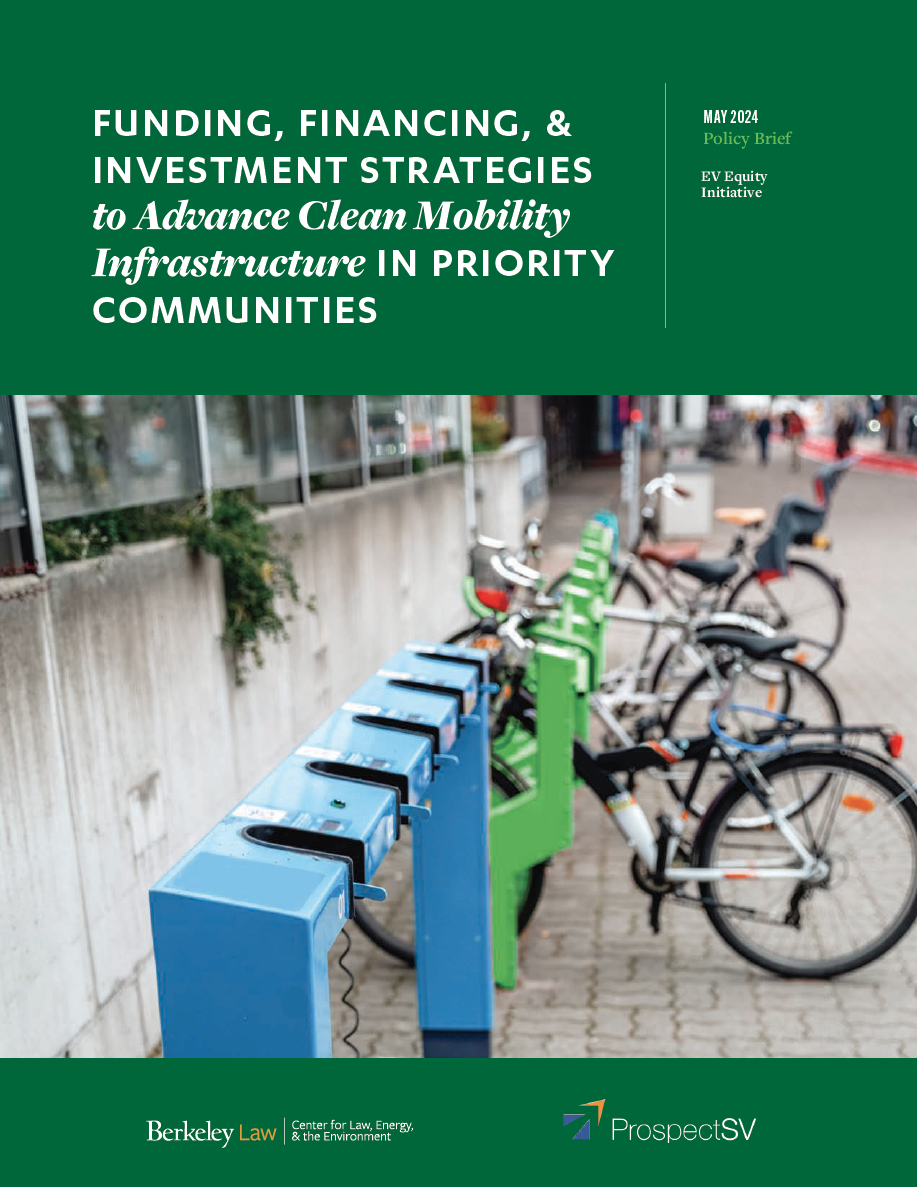
The transition to 100 percent zero-emission vehicle (ZEV) sales by 2035 will require massive investment in electric vehicle charging infrastructure throughout California and in other states that have adopted the same phaseout targets. Ensuring that California’s priority populations are included in and benefit from the ZEV transition in a timely manner will rely heavily on proactive strategies that deliver equitable access to public charging infrastructure.
As part of our joint Equitable Mobility Initiative, CLEE and Prospect Silicon Valley convened an advisory group of experts in climate and public finance, clean mobility, and city infrastructure investment to develop innovative proposals to address this challenge. Our resulting report outlines the top financing and revenue strategies identified by the group to bring city-scale and mobility infrastructure solutions to fruition.
Read the report: Funding, Financing, & Investment Strategies to Advance Clean Mobility Infrastructure in Priority Communities
Scoping the Public Health Impacts of Wildfire: A Primer for Stakeholders
May 2024 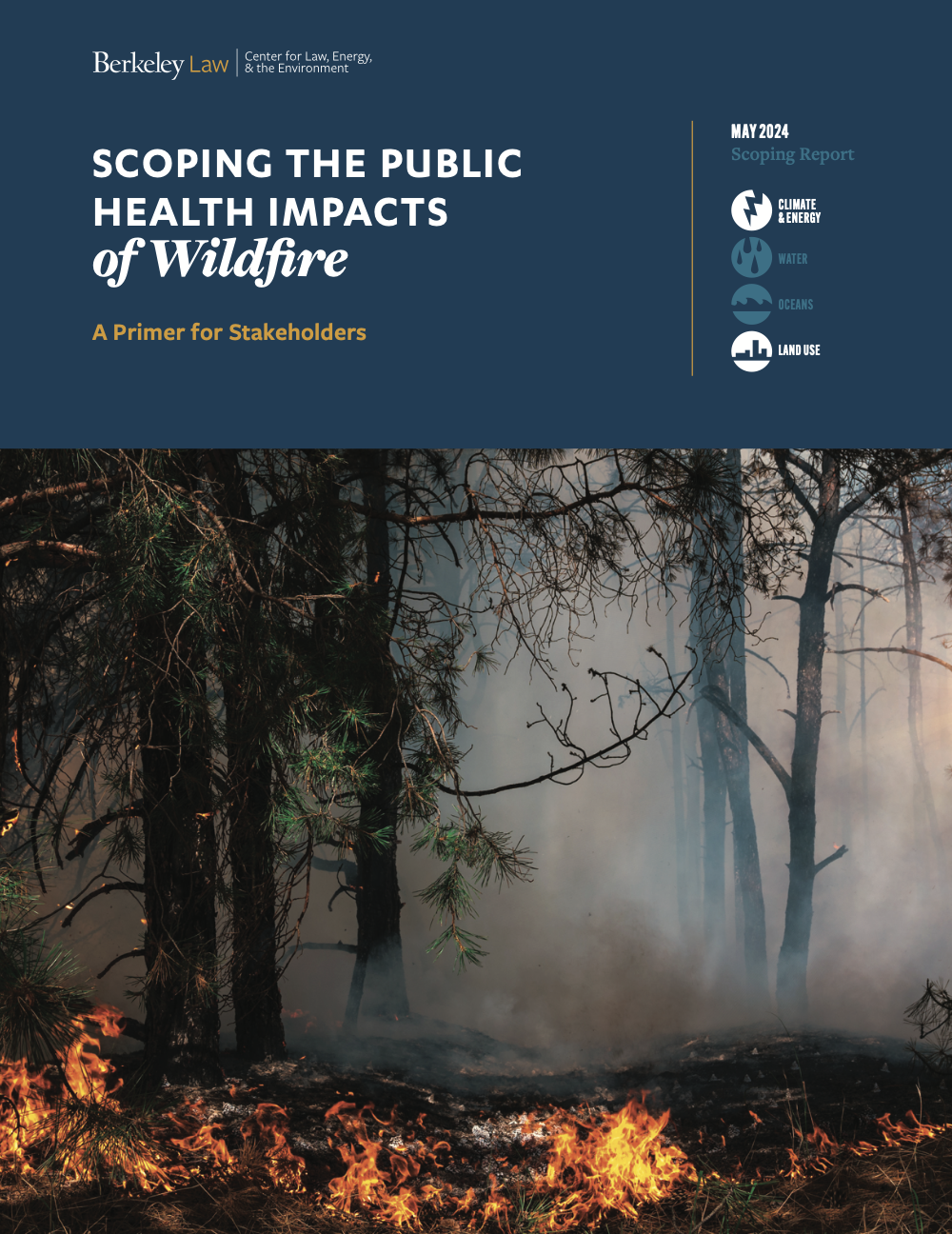
Wildfire smoke presents a population-wide health risk in California. Catastrophic wildfires are fueling complex and extensive public health impacts, including air pollution-related mortality and a growing toll on mental health. These risks result in hundreds of millions of dollars in estimated losses and carry stark environmental justice implications for vulnerable populations. At the same time, the policy landscape addressing this issue remains siloed on the state and federal level, posing challenges to integrated policy development and implementation. Further research is needed into many areas of the issue, most notably the comparative health impacts of prescribed fire and avenues for building community resilience.
This scoping report, in partnership with the Climate & Wildfire Institute, offers a primer for stakeholders interested in the intersections of wildland fire and public health. The report investigates key issues in the physical and mental health impacts of wildfire, provides an overview of the current state and federal policy landscape, and presents recommendations for future resilience.
Read the report: Scoping the Public Health Impacts of Wildfire: A Primer for Stakeholders
Offshore Wind & Community Benefits Agreements in California: CBA Examples
April 2024
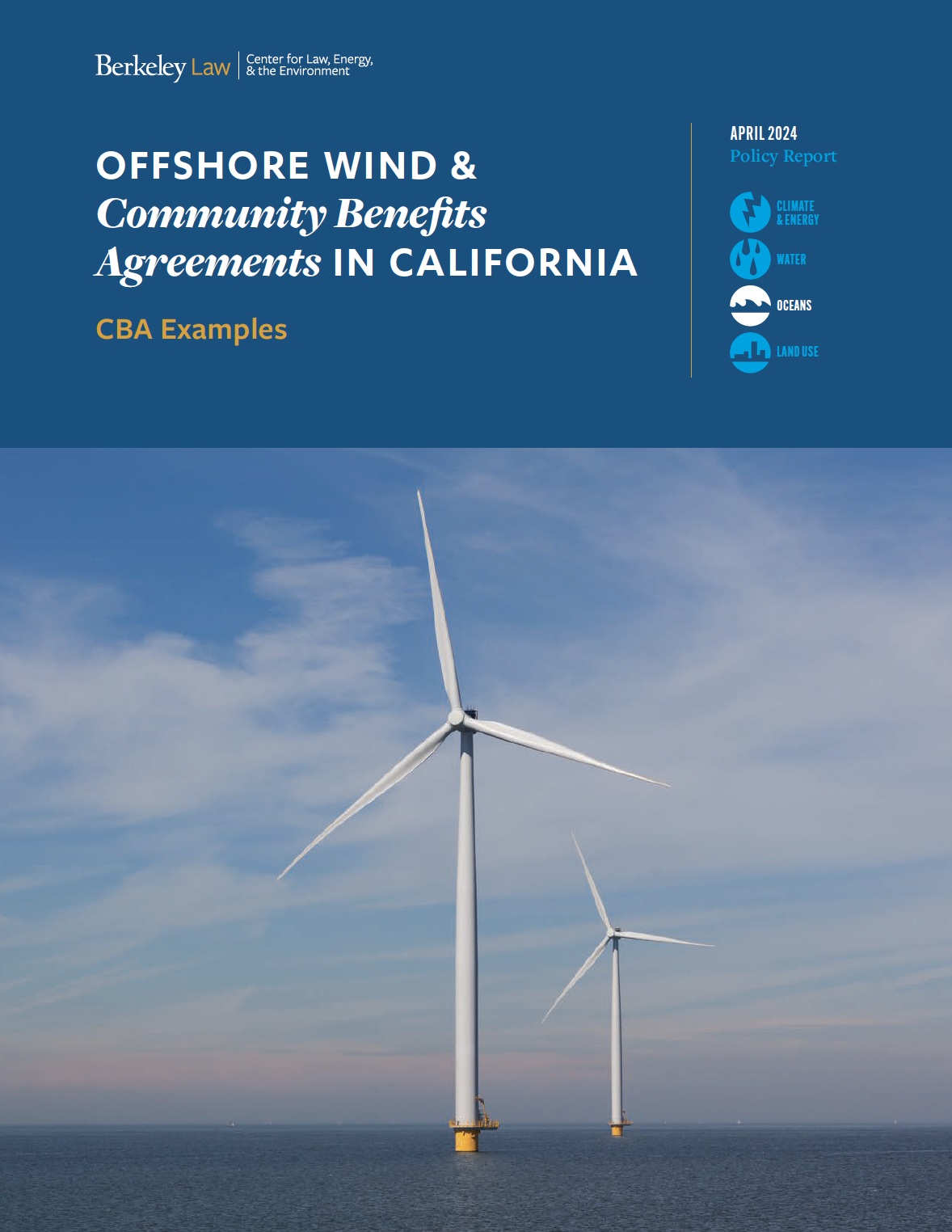 California’s goal of achieving 25 gigawatts of offshore wind electricity by 2045 will help the State meet its carbon neutrality target and will also have transformative effects on the State’s economy and communities. Community Benefits Agreements (CBAs) are tools that can enable local communities to have a voice in the development of new projects and ensure that the state’s transition to offshore wind creates sustainable, equitable economic opportunity, and local investment. CLEE’s report, Offshore Wind & Community Benefits Agreements in California: CBA Examples, highlights the community-oriented measures and CBAs in California’s existing offshore wind leases and presents select CBA examples and community benefits provisions from the real estate and manufacturing sectors, as well as from east coast and UK wind farm projects. These examples can provide important models and lessons for offshore wind development in California. The report also lifts up important considerations and elements—such as CBA structure, process and representation, and oversight and accountability—that can help ensure future California CBAs are rooted in impacted communities and reflect stakeholders’ values and needs.
California’s goal of achieving 25 gigawatts of offshore wind electricity by 2045 will help the State meet its carbon neutrality target and will also have transformative effects on the State’s economy and communities. Community Benefits Agreements (CBAs) are tools that can enable local communities to have a voice in the development of new projects and ensure that the state’s transition to offshore wind creates sustainable, equitable economic opportunity, and local investment. CLEE’s report, Offshore Wind & Community Benefits Agreements in California: CBA Examples, highlights the community-oriented measures and CBAs in California’s existing offshore wind leases and presents select CBA examples and community benefits provisions from the real estate and manufacturing sectors, as well as from east coast and UK wind farm projects. These examples can provide important models and lessons for offshore wind development in California. The report also lifts up important considerations and elements—such as CBA structure, process and representation, and oversight and accountability—that can help ensure future California CBAs are rooted in impacted communities and reflect stakeholders’ values and needs.
Read the report: Offshore Wind & Community Benefits Agreements in California: CBA Examples
Watch the Lunch & Learn Webinar: California Offshore Wind & Community Benefits Agreements: CBA Examples Webinar
Case Studies: City Public & Curbside Charging Strategies
March 2024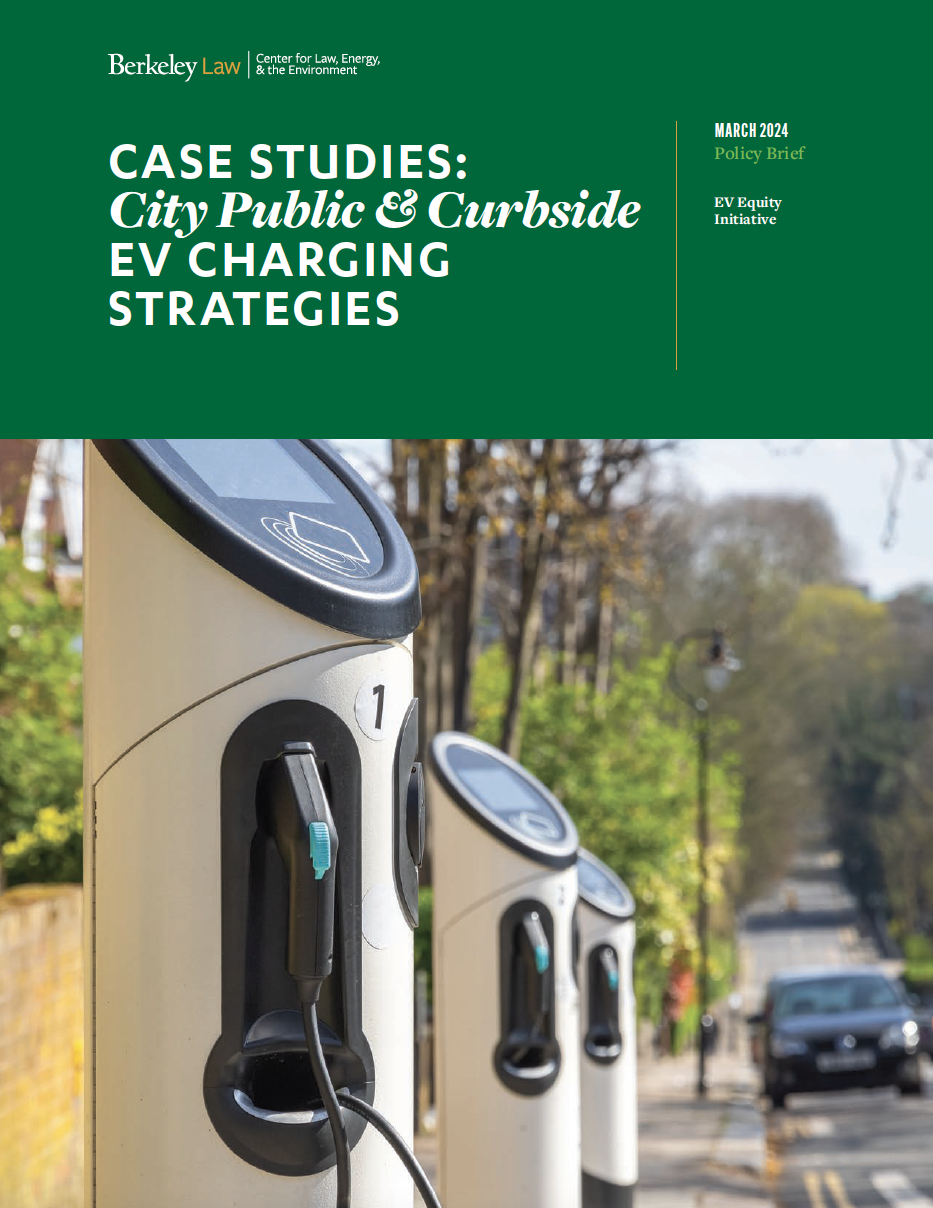
As California and other states transition to one hundred percent zero-emission new vehicle (ZEV) sales by 2035, local governments will play a crucial role in addressing inequities in the ZEV transition. Curbside and public right-of-way (PROW) locations are a key venue for city governments to lead electric vehicle (EV) infrastructure development and deliver a more equitable charging network for residents. Publicly accessible areas may provide particularly useful charging options for residents in underserved communities who are likely to lack access to charging in private driveways or garages, in multifamily dwelling parking lots, or at workplaces.
Our case study report, informed by interviews with city leaders and EV charging project directors, gathers insights from city programs that are leading efforts to expand charging infrastructure in the PROW. This policy brief is intended to guide local leaders as they plan and execute public EV charging infrastructure development with a focus on equitable investment.
Read the report: Case Studies: City Public & Curbside Charging Strategies
California’s 2021 Year in Fire: Fire and Resilience Impacts Beyond Acres Burned
February 2024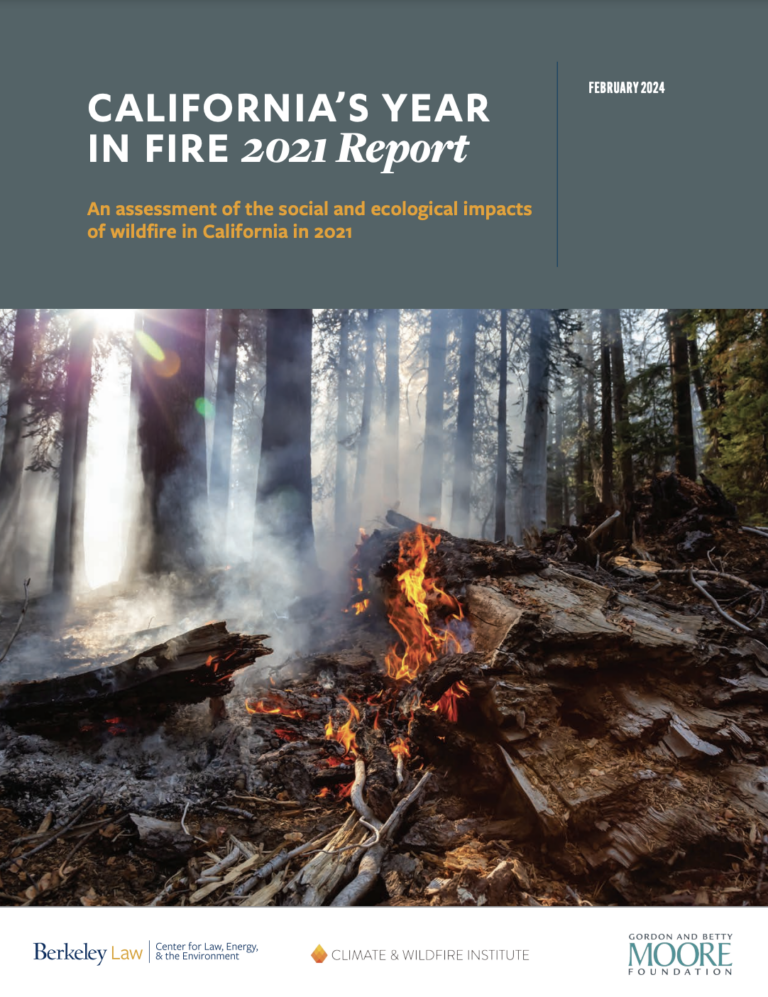
How are wildfires impacting California, and how are those impacts evolving? A wide variety of wildfire impacts are either not tracked or not reported, thereby limiting our ability to make informed decisions in wildfire mitigation and recovery efforts. And this truncated access to essential information and data has the potential to lead us to unsustainable solutions; for example, if we judge wildfire impacts by the number of acres burned each year and focus primarily on reducing that number, the rational response might be to bolster fire suppression. To do so, however, would ignore a wide range of other social and ecological impacts and the opportunity to improve overall ecological and community health and resilience.
The California’s Year in Fire project, in partnership with the Climate & Wildfire Institute and the Gordon and Betty Moore Foundation, advances a framework for a more complete picture of evolving impacts and consequences, and provides more robust data points to inform meaningful solutions.
Read the report: California’s 2021 Year in Fire: Fire and Resilience Impacts Beyond Acres Burned
January 2024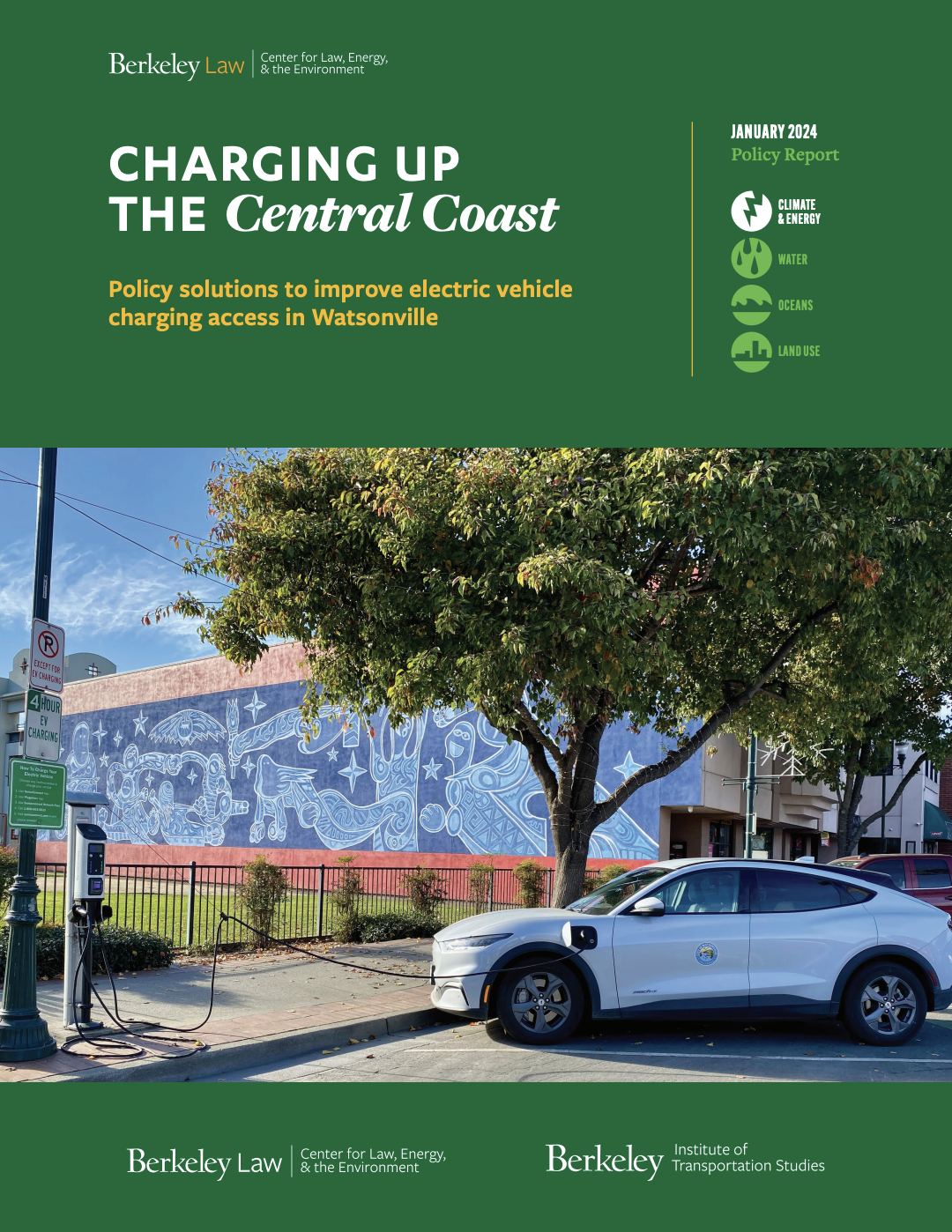
California’s goal to eliminate internal combustion engine sales by 2035 poses challenges for lower- and moderate-income residents, hindering their access to electric vehicles (EVs). Barriers include limited EV charging stations, exacerbated by lower home ownership and inadequate grid infrastructure in lower-income communities.
To address this, UC Berkeley School of Law’s Center for Law, Energy & the Environment (CLEE) partnered with the City of Watsonville. Due to its location, demographics, and ambitious policy goals, Watsonville represents a potential model and case study for other cities around the state grappling with how to boost EV charging infrastructure. CLEE conducted stakeholder interviews and a convening in Watsonville in May 2023, and developed a set of policy recommendations for both state and local entities to accelerate investment in EV charging infrastructure in Watsonville, which could inform other cities facing similar challenges and seeking to meet state targets and residents’ needs.
Read the report: Charging up the Central Coast: Policy solutions to improve electric vehicle charging access in Watsonville
January 2024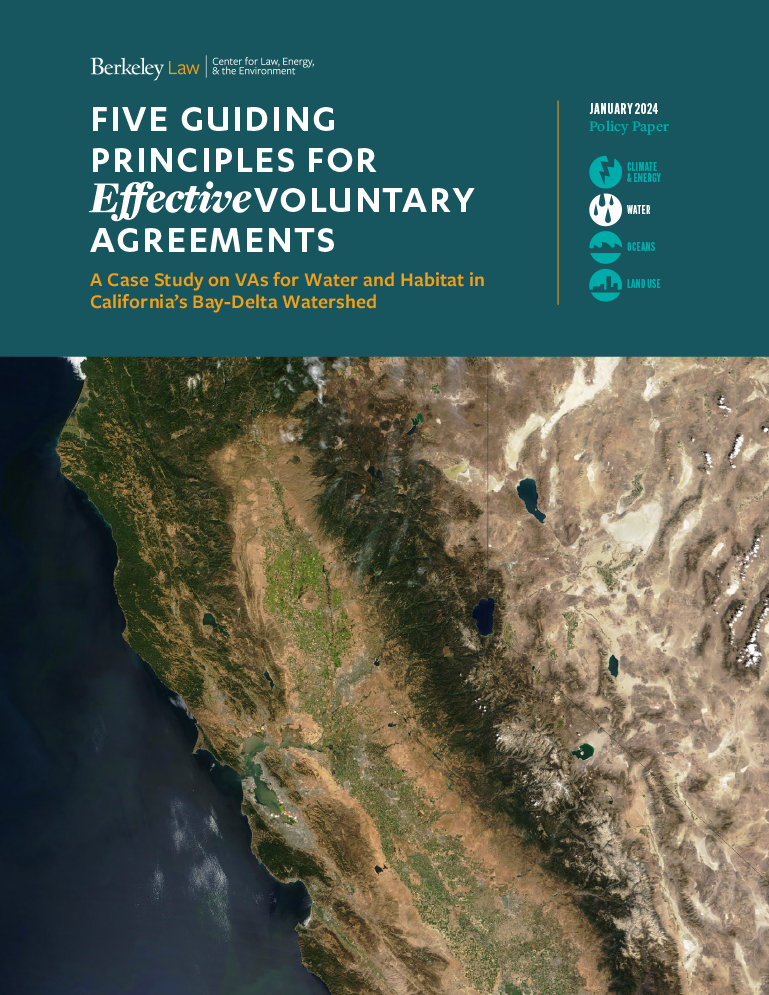
California has increasingly emphasized efforts to develop voluntary agreements (VAs) with water users as a means of achieving regulatory goals in certain watersheds. In theory, a VA can combine the protectiveness of a regulatory backstop with the creativity and flexibility of a negotiated deal to produce outcomes as good as, or better than, those achievable through strict application of regulatory requirements alone. However, reality has not always measured up to this ideal. This policy paper uses the Bay-Delta watershed as a case study to inform five principles to guide the appropriate use and evaluation of VAs.
Read the report: Five Guiding Principles for Effective Voluntary Agreements: A Case Study on VAs for Water and Habitat in California’s Bay-Delta Watershed
CLEE 2023 Snapshot Annual Report
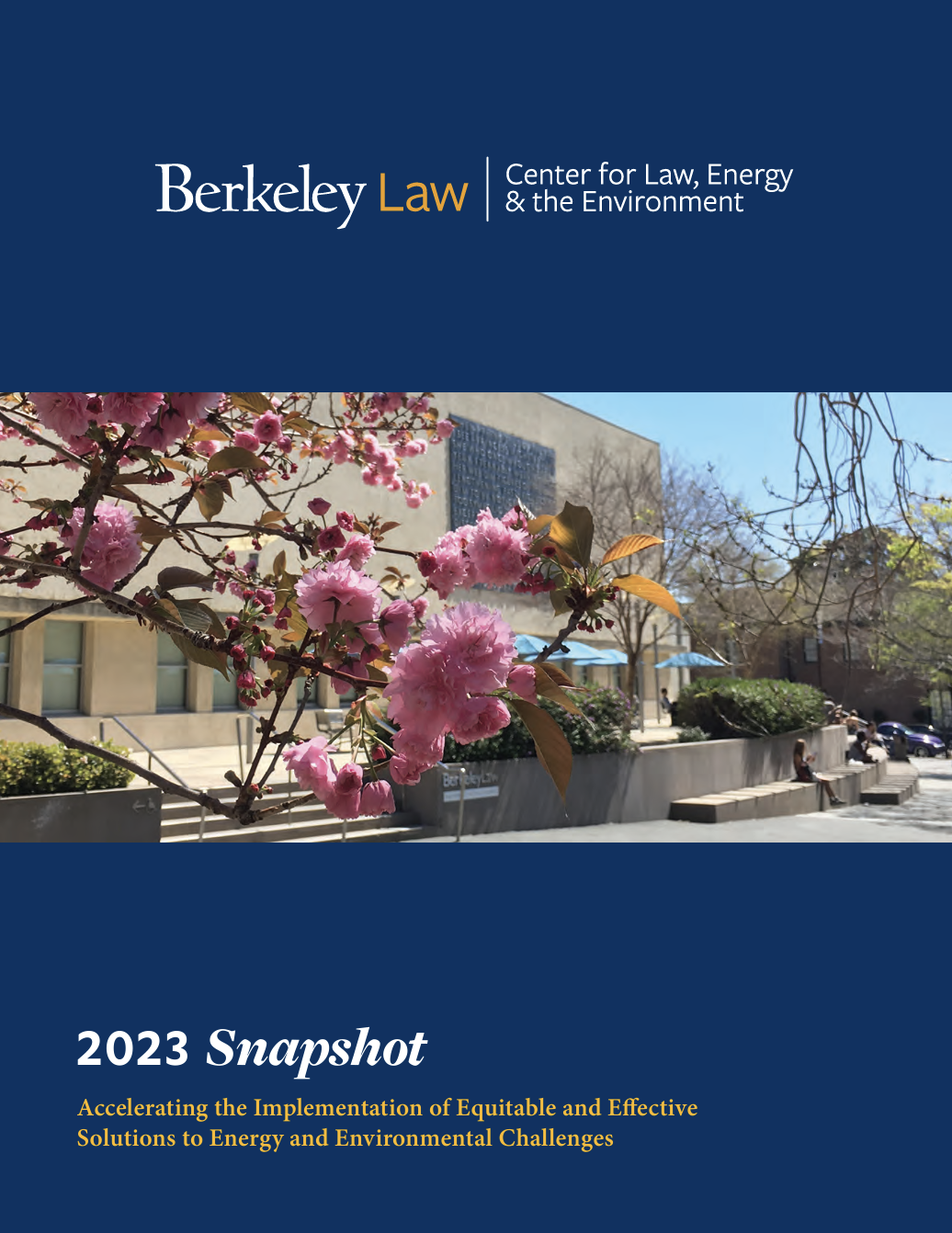 Every year, we take some time to reflect on CLEE’s mission and what we have accomplished towards that end. Our 2023 Snapshot report showcases our work over the past year and our strides in three strategic areas:
Every year, we take some time to reflect on CLEE’s mission and what we have accomplished towards that end. Our 2023 Snapshot report showcases our work over the past year and our strides in three strategic areas:
- Actionable Research: Developing and disseminating research that directly informs and influences policy and practice.
- Training and Education: Equipping current and future environmental leaders with the knowledge and skills to make a difference.
- Communication and Engagement: Nurturing the continued growth of an informed and engaged community.
These are the pillars of our new strategic plan, providing a structure for building on CLEE’s 18 years of expertise and experience. Your partnership and support have been instrumental in our journey and will remain so in the months and years to come. The challenges we face are daunting, but we are optimistic that together, we can create an even more meaningful impact.
Please join us in celebrating our achievements and recommitting to the pursuit of sustainable and equitable environmental solutions.
Read the CLEE Snapshot Annual Report here, or download a copy.
An Initial Review of the ICARP Regional Resilience Planning and Implementation Grant Program
December 2023 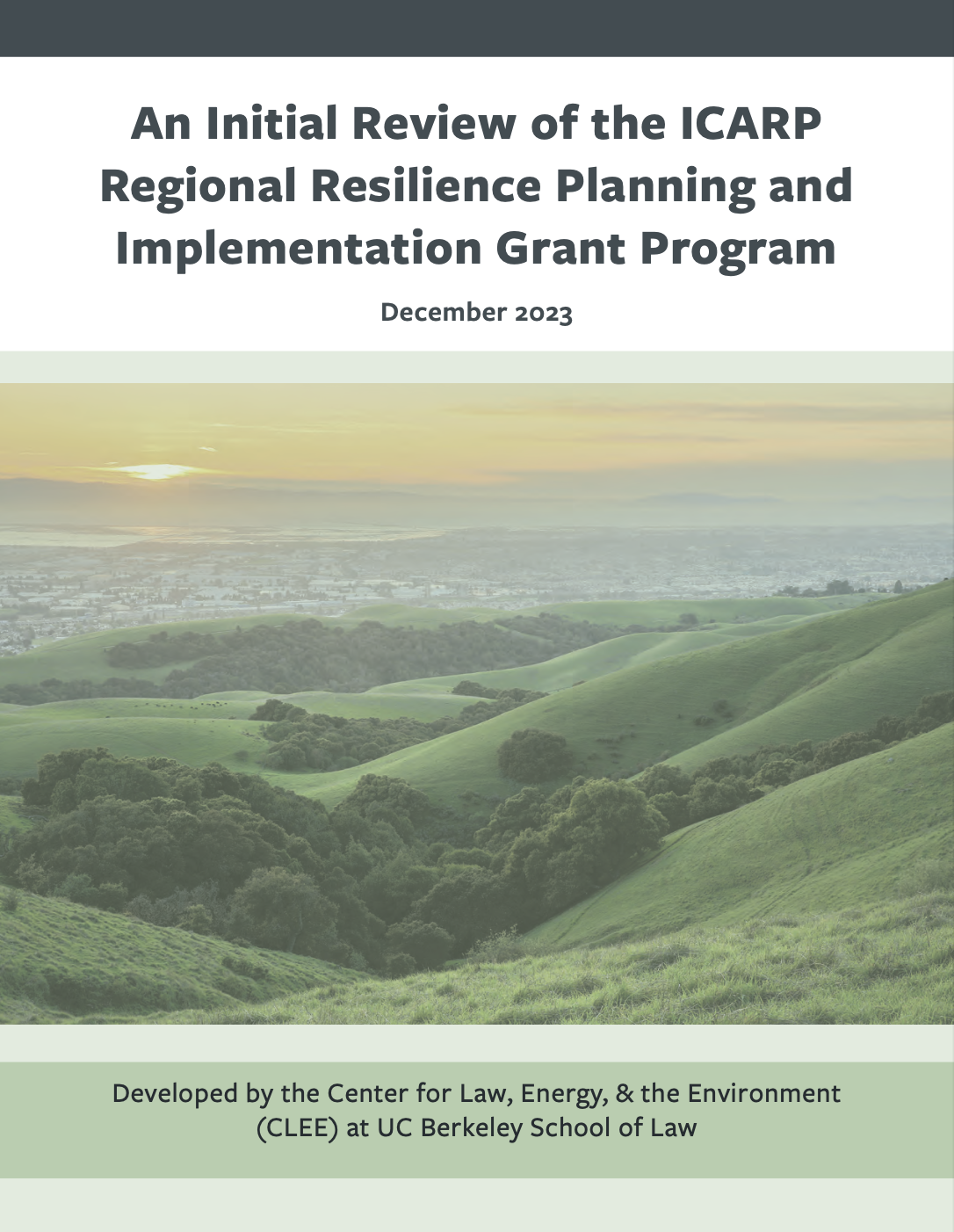
Funding climate resilience and fostering regional collaboration is crucial for California as the State faces escalating climate threats. A regional approach to resilience enables communities to address the multifaceted challenges created by climate change that transcend political boundaries. Regional perspectives on resilience planning allow for a more holistic understanding of shared resources, interconnected systems, and common vulnerabilities.
The Integrated Climate Adaptation and Resiliency Program (ICARP) in the Governor’s Office of Planning and Research (OPR) administers the Regional Resilience Planning and Implementation Grant Program (RRGP). RRGP supports collaborative projects to address significant climate change risks, especially in vulnerable communities. The program allows applicants to identify the regions they serve based on shared natural and built systems and priority climate risks, ensuring a more inclusive response to climate change.
CLEE’s report evaluates the first round of RRGP and makes recommendations to improve regional approaches to resilience. This report focuses on program development, applications, and the outcomes of the first round of program awards. Based on this analysis, which includes program data and stakeholder interviews, the recommendations address challenges and opportunities for the future growth of RRGP and regional resilience planning more broadly.
Read the report: An Initial Review of the ICARP Regional Resilience Planning and Implementation Grant Program
International Monetary Fund Reform
November 2023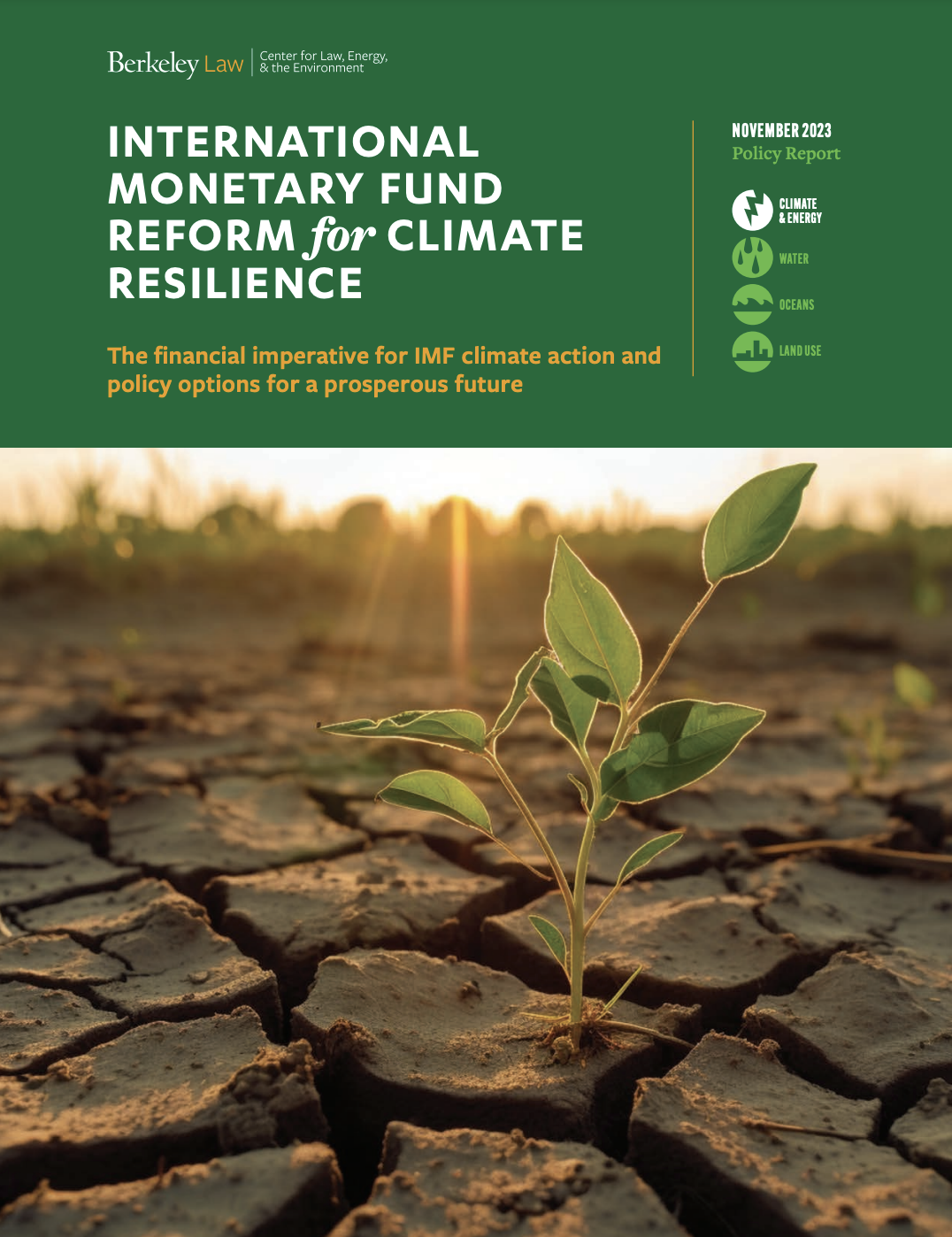
CLEE’s new report, “International Monetary Fund Reform for Climate Resilience,” describes how the International Monetary Fund (IMF), a multilateral institution charged with maintaining global economic stability and growth, can help steer the international community toward a more sustainable economic future.
The report analyzes how current IMF lending and advising practices inadvertently worsen the climate crisis and the associated financial risk, and it outlines a comprehensive approach to address these challenges and overcome political, financial, technical, and institutional barriers to action.
Read the report: International Monetary Fund Reform
November 2023
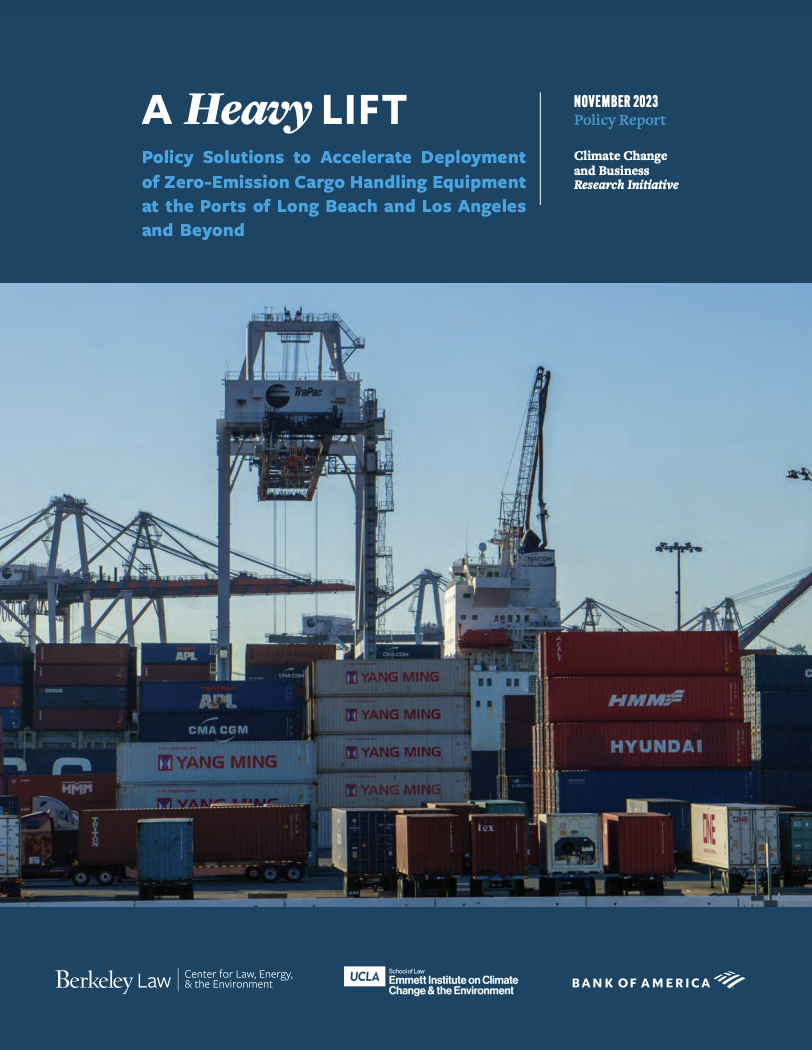 The movement of goods through the Ports of Los Angeles and Long Beach is a major source of air pollution and greenhouse gas emissions in the L.A. region. The South Coast Air Quality Management District has reported that the Ports are “the single largest fixed source of air pollution in Southern California.” And neighboring communities—predominantly low-income communities of color—bear the brunt of this pollution, suffering from smog and toxic air pollution from port equipment.
The movement of goods through the Ports of Los Angeles and Long Beach is a major source of air pollution and greenhouse gas emissions in the L.A. region. The South Coast Air Quality Management District has reported that the Ports are “the single largest fixed source of air pollution in Southern California.” And neighboring communities—predominantly low-income communities of color—bear the brunt of this pollution, suffering from smog and toxic air pollution from port equipment.
This new report surveys the biggest obstacles to speedy electrification, including inadequate grid and charging infrastructure, evolving zero-emission technology for cargo handling equipment, and fear among communities and workers of job loss and of increased emissions from expanded port activities. The report also presents policy solutions to get around these obstacles.
Read the report: A Heavy Lift: Policy Solutions to Accelerate Deployment of Zero-Emission Cargo Handling Equipment at the Ports of Long Beach and Los Angeles and Beyond
Getting to Implementation: The Status of Local Climate Action in California
November 2023
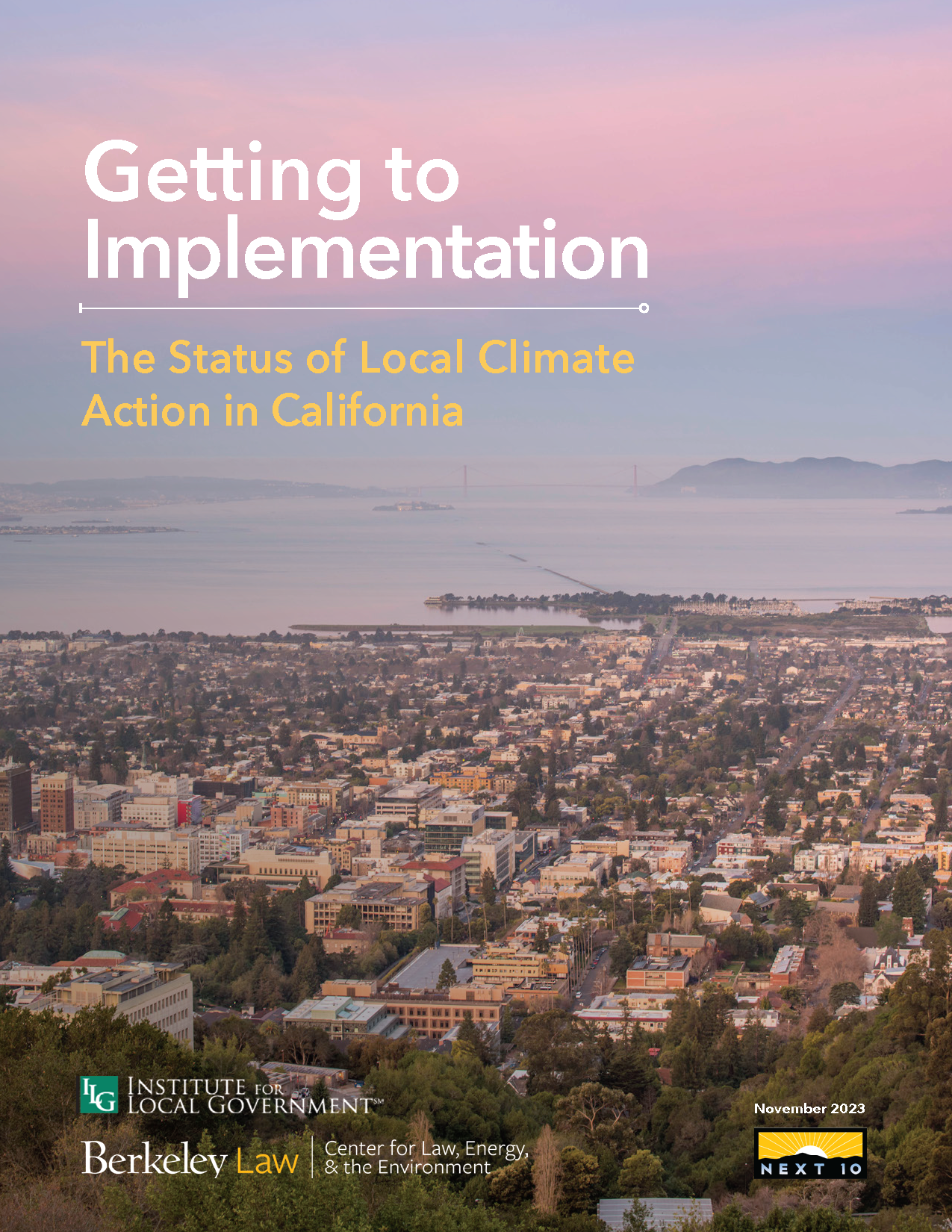
California’s local governments, which include cities, counties, and special districts, play a pivotal role in shaping the State’s transition to a decarbonized economy. However, jurisdictions across the state have varying levels of success in implementing climate policies and programs. CLEE’s new report, Getting to Implementation: The Status of Local Climate Action in California, summarizes the results of a statewide survey on local governments’ efforts to address climate change, conducted in partnership with the Institute for Local Government(opens in a new tab) (ILG).
The California Local Government Climate Activity Survey, which was open from April to May 2023, gathered information on existing efforts to address climate change, opportunities for strategic climate policy and planning, and barriers to the timely implementation of climate solutions. The survey was designed to help assess the current status of climate action planning efforts and policy implementation, identify opportunities and barriers to move from planning to implementation, and increase understanding of resource constraints, barriers, and opportunities to advance action across a range of policy areas.
The report authors want to thank Next 10 for their support and partnership on this project.
Read the report: Getting to Implementation: The Status of Local Climate Action in California
October 2023
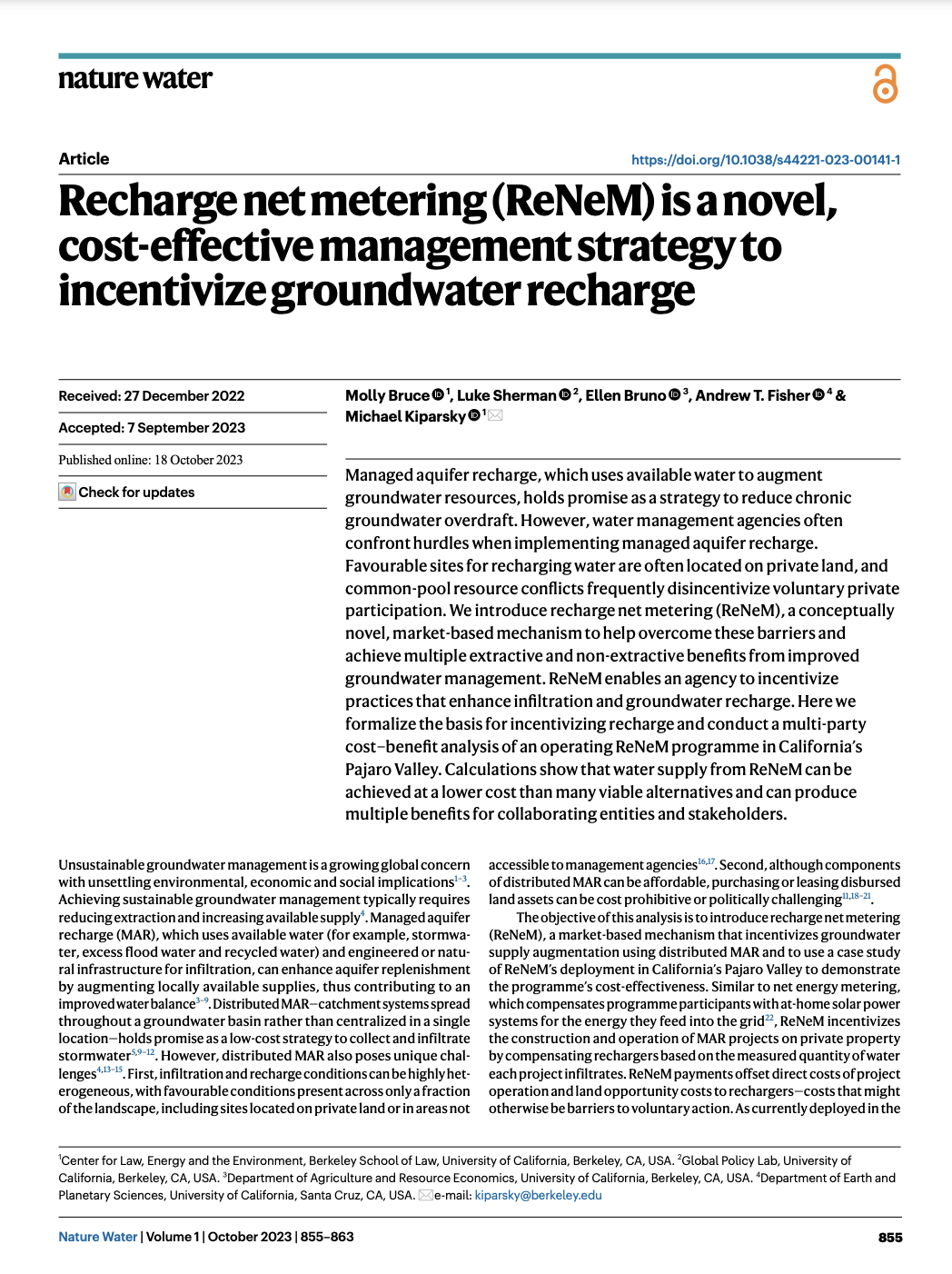
Groundwater basins are mismanaged throughout California and the world, with dire economic, social, and environmental consequences. Managed aquifer recharge is emerging as an important method for bringing groundwater budgets into balance. However, although the best sites for recharge are often located on private property, property owners typically are not incentivized to invest in groundwater projects for the benefit of the basin. To address this gap, our team is supporting the development of recharge net metering (ReNeM), a new incentive structure that compensates private entities for operating groundwater recharge projects on their land.
CLEE led a team of co-authors from UC Berkeley and UC Santa Cruz to publish an economic analysis of ReNeM in Nature Water, titled “Recharge net metering (ReNeM) is a novel, cost-effective management strategy to incentivize groundwater recharge.” The article showcases ReNeM’s affordability and cooperative promise; it provides water managers with a method for understanding ReNeM’s financial implications; and it enables expansion of this new approach to groundwater management elsewhere.
Read the article: Recharge net metering (ReNeM) is a novel, cost-effective management strategy to incentivize groundwater recharge, Nature Water
Comment Letter re: U.S. Department of Energy Responsible Carbon Management Initiative
September 2023
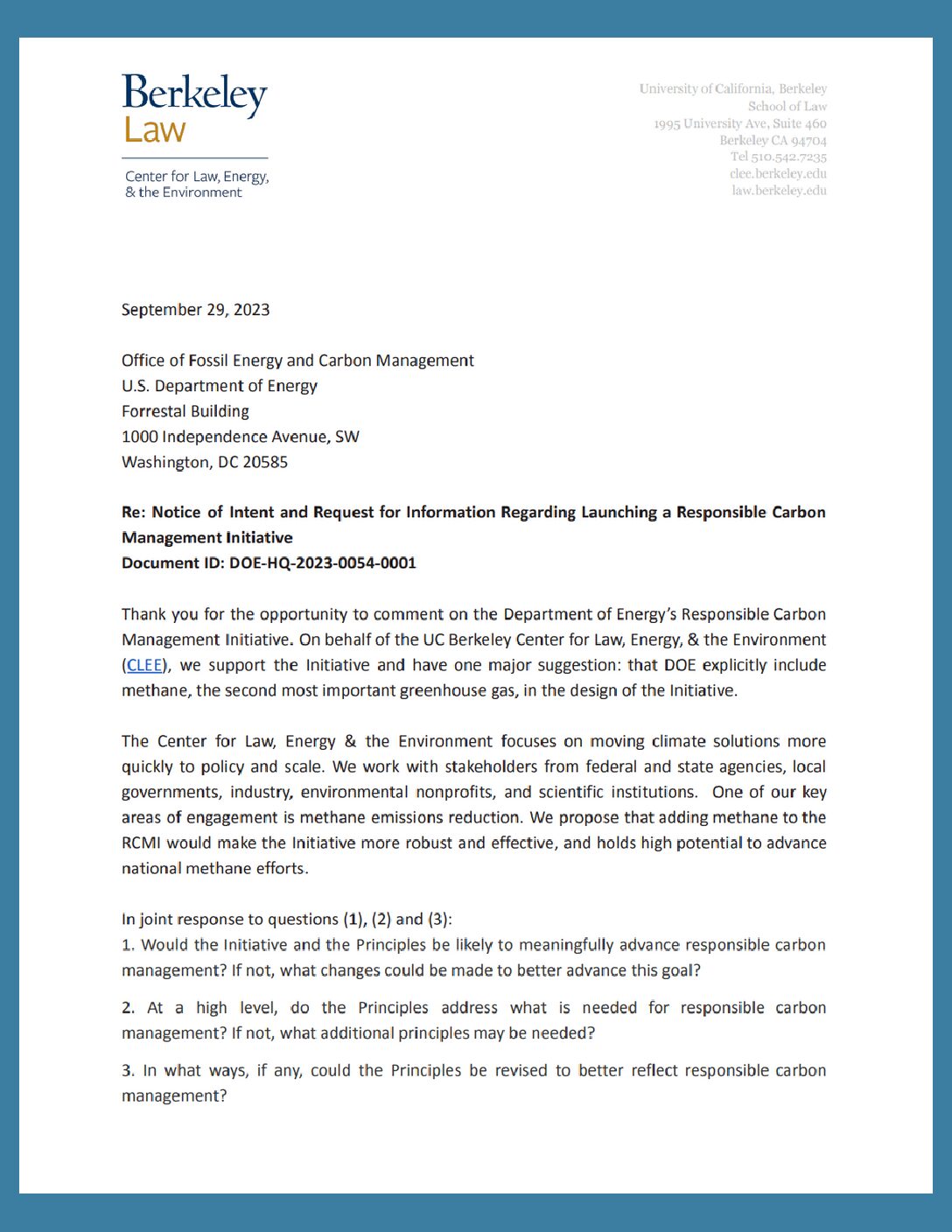
On August 11, 2023, the U.S. Department of Energy (DOE) announced the launch of the Responsible Carbon Management Initiative, outlining principles for industry developers to abide by, providing framework for the prioritization of “safety, environmental stewardship, accountability, community engagement, and societal benefits in carbon management projects.” (DOE) In an official comment on the initiative responding to their “Notice of Intent and Request for Information Regarding Launching a Responsible Carbon Management Initiative,” Ken Alex, Director of Project Climate, along with CLEE Research Fellows Shivani Shukla and Gil Damon, urge the DOE to consider methane in the design of the Initiative.
Read our comment letter: Comment Letter re: U.S. Department of Energy Responsible Carbon Management Initiative
September 2023
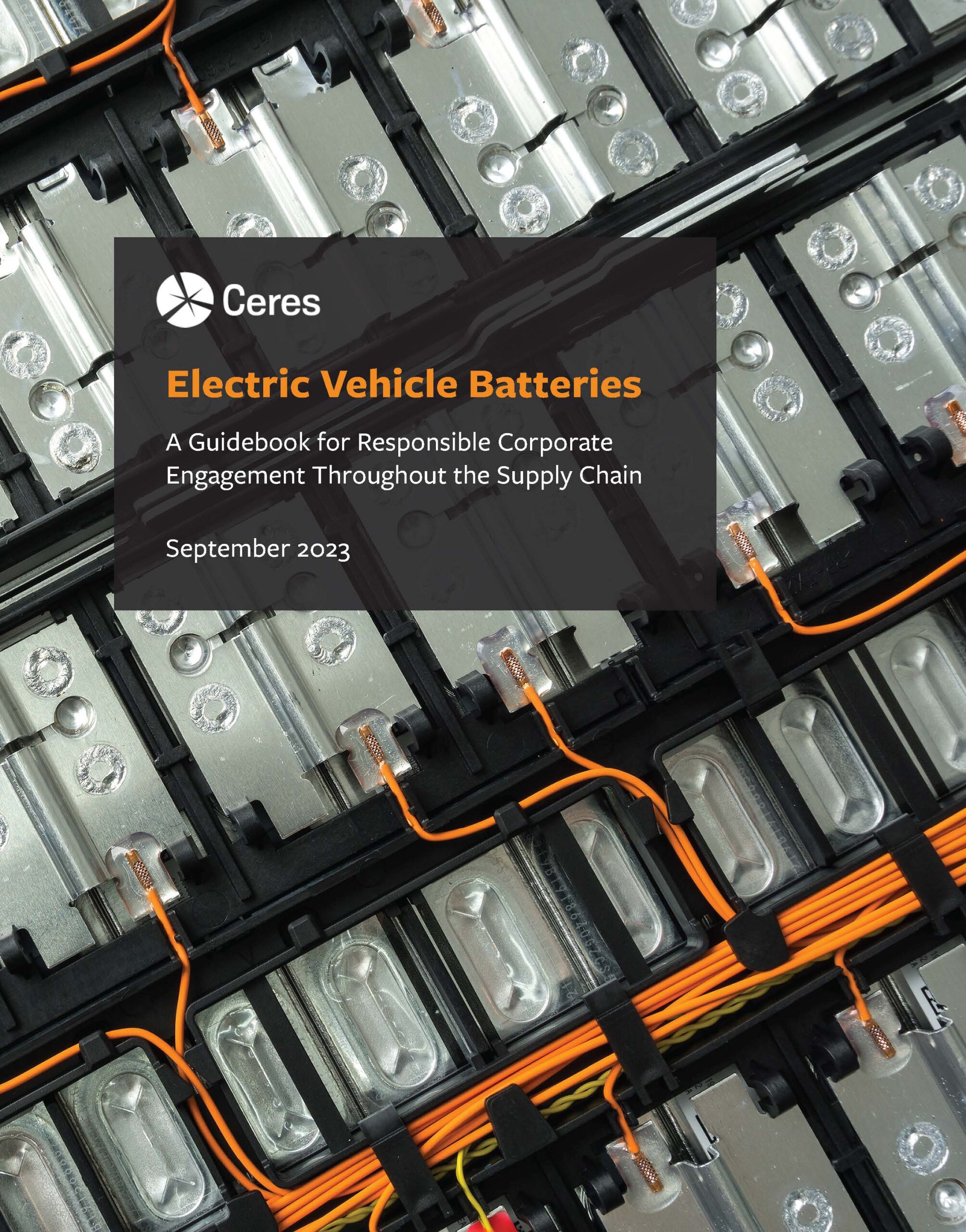 The Corporate Electric Vehicle Alliance (opens in a new tab)(CEVA), led by Ceres, is a collaborative group of companies focused on accelerating the transition to EVs. Our new report for CEVA, in partnership with Ceres, offers recommendations for major corporate EV fleet purchasers for how they can help ensure EV supply chain sustainability. It summarizes the market status of the batteries, U.S. policy context, and key initiatives for improvement.
The Corporate Electric Vehicle Alliance (opens in a new tab)(CEVA), led by Ceres, is a collaborative group of companies focused on accelerating the transition to EVs. Our new report for CEVA, in partnership with Ceres, offers recommendations for major corporate EV fleet purchasers for how they can help ensure EV supply chain sustainability. It summarizes the market status of the batteries, U.S. policy context, and key initiatives for improvement.
Access the full report here: Electric Vehicle Batteries: A Guidebook for Responsible Corporate Engagement Throughout the Supply Chain
Read more about our larger initiative here: Building a Sustainable Electric Vehicle Battery Supply Chain
Offshore Wind & Community Benefits Agreements in California: An Introduction
June 2023
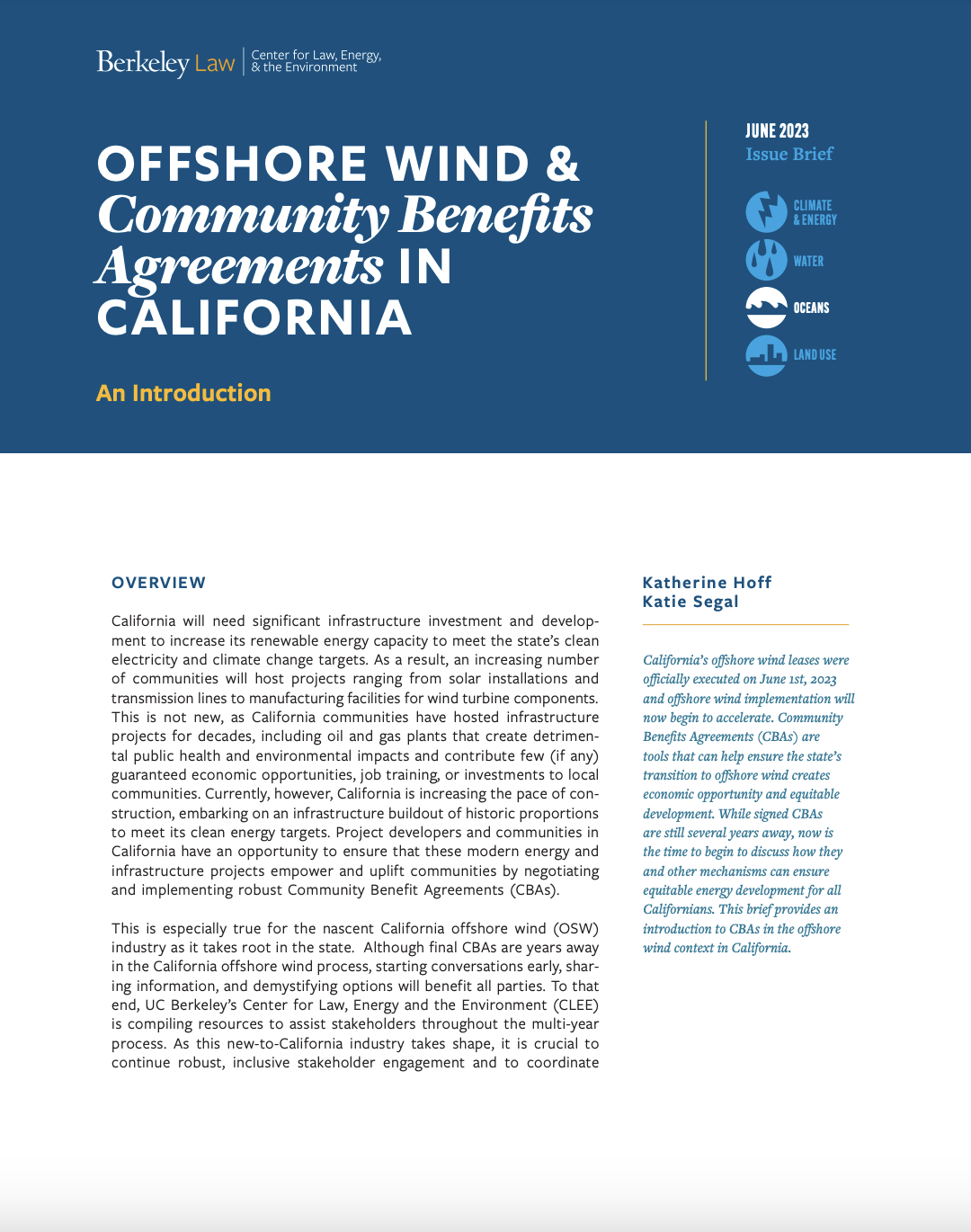 Developers and communities in California have an opportunity to ensure that offshore wind energy and infrastructure projects empower and uplift communities by negotiating and implementing robust Community Benefit Agreements (CBAs). A Community Benefits Agreement, or CBA, is a legally binding, enforceable contract signed by project developers and community groups or coalitions of groups. CBAs can help create space for residents to have a voice in the future of their communities and can expand economic opportunity and make development more equitable. CBAs can also increase transparency and enforceability of outcomes, boost coalition building, and clarify outcomes. CLEE’s Issue Brief, Offshore Wind & Community Benefits Agreements in California: An Introduction, examines Community Benefits Agreements and explores how they might be relevant in the California offshore wind context.
Developers and communities in California have an opportunity to ensure that offshore wind energy and infrastructure projects empower and uplift communities by negotiating and implementing robust Community Benefit Agreements (CBAs). A Community Benefits Agreement, or CBA, is a legally binding, enforceable contract signed by project developers and community groups or coalitions of groups. CBAs can help create space for residents to have a voice in the future of their communities and can expand economic opportunity and make development more equitable. CBAs can also increase transparency and enforceability of outcomes, boost coalition building, and clarify outcomes. CLEE’s Issue Brief, Offshore Wind & Community Benefits Agreements in California: An Introduction, examines Community Benefits Agreements and explores how they might be relevant in the California offshore wind context.
Read the report: Offshore Wind & Community Benefits Agreements in California: An Introduction
June 2023
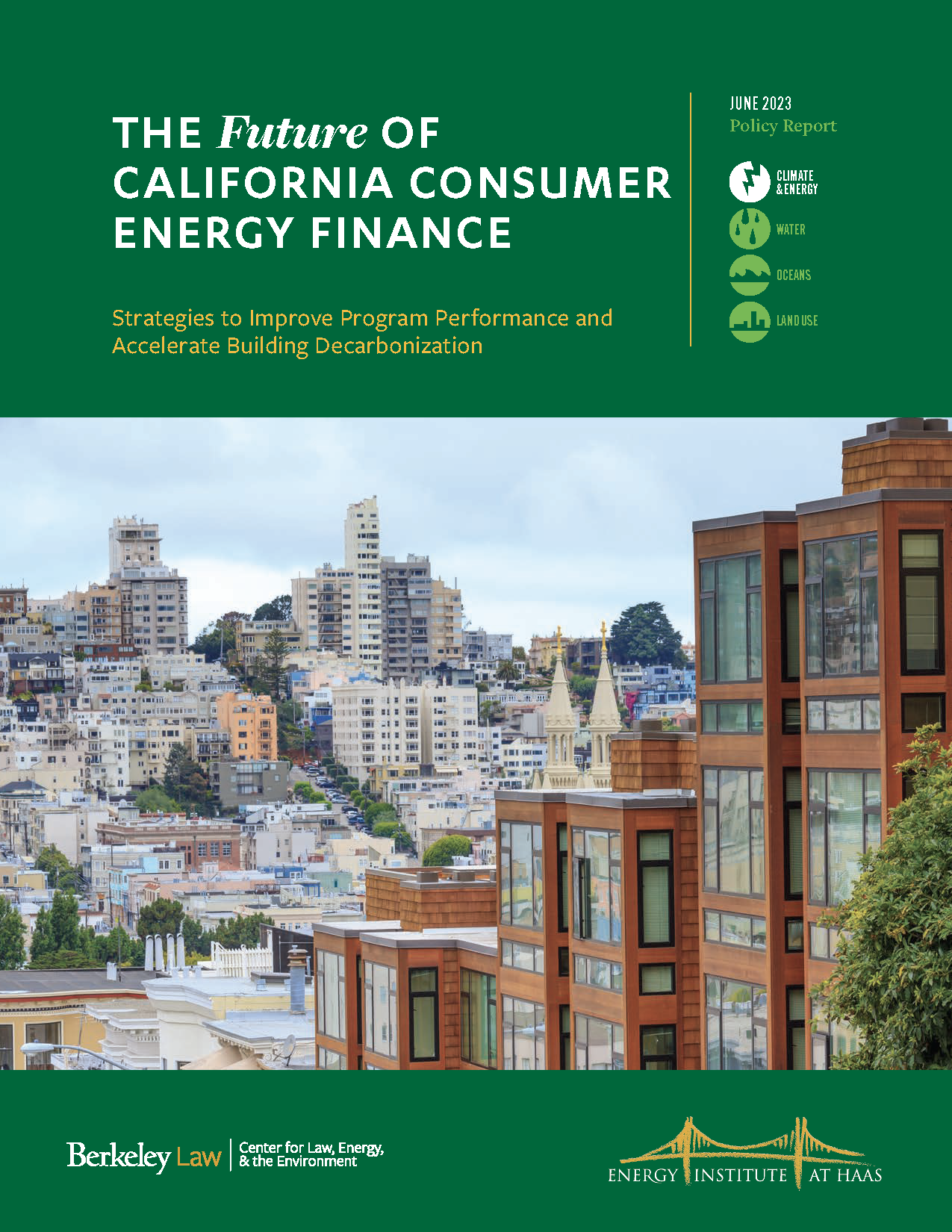 Among all the sectors California leaders need to address to achieve statewide carbon neutrality by 2045(opens in a new tab), existing buildings (which are responsible for over 10 percent of state emissions)—in particular existing residential structures—are among the most difficult to decarbonize. The state has established a range of different programs to address the problem, including a number of appliance-specific and whole-building retrofit subsidy programs, but public funds are inadequate to cover all the needed upgrades. Our report, The Future of California Energy Finance, a collaboration between CLEE and the Energy Institute at Haas(opens in a new tab), considers the future of California energy finance and lays out strategies to supplement and improve the reach of California’s consumer financing programs.
Among all the sectors California leaders need to address to achieve statewide carbon neutrality by 2045(opens in a new tab), existing buildings (which are responsible for over 10 percent of state emissions)—in particular existing residential structures—are among the most difficult to decarbonize. The state has established a range of different programs to address the problem, including a number of appliance-specific and whole-building retrofit subsidy programs, but public funds are inadequate to cover all the needed upgrades. Our report, The Future of California Energy Finance, a collaboration between CLEE and the Energy Institute at Haas(opens in a new tab), considers the future of California energy finance and lays out strategies to supplement and improve the reach of California’s consumer financing programs.
April 2023
California’s insurance industry faces significant risks from climate change, including both the transition risks facing all financial institutions as the global economy shifts toward decarbonization and the singular combination of physical risks—wildfire, drought, coastal hazards, extreme heat—that threaten California’s communities and businesses.
CLEE’s report, Looking Forward, explores the field of climate risk scenario analysis—a key instrument to assess financial risk in projected future scenarios—and makes recommendations for the California Department of Insurance to design scenario analysis exercises and engage California insurance companies in forward-looking risk assessment. The report analyzes precedent and decision-making criteria for structural elements such as “top-down” (regulator-led) versus “bottom-up” (insurer-led) exercises, scope of risks assessed, time horizons, strategic partnerships, and more.
Managing Water Scarcity: A Framework for Fair and Effective Water Right Curtailment in California
April 2023
When there is not enough water to satisfy all demands, water must be allocated among competing human and environmental uses. California’s State Water Resources Control Board (SWRCB) is responsible for ensuring that surface water is diverted and used in accordance with state and federal legal requirements and policy priorities. Our new report, Managing Water Scarcity, explains how to bring the SWRCB’s capabilities in line with California’s needs. The report describes the legal context for water right curtailments in California, summarizes the history of curtailment practices in the state, and recommends actions California can take to build an effective framework for curtailment. The SWRCB can implement some of the actions we recommend on its own. But we also recommend swift and decisive legislative action to clarify and enhance the agency’s tools and authority.
March 2023
CLEE’s March 2023 whitepaper, Stakeholder Engagement in California Offshore Wind, summarizes key themes heard throughout the 2022 stakeholder engagement series about the general planning process, equity and environmental justice priorities, environmental considerations, tribal government input, developer perspectives, and fishing industry input. Examples include requests for greater inclusion and engagement with stakeholders, better transparency and accessibility of data sources that inform decision making, additional studies and data collection, prioritization of community and economic benefits, development of long-term workforce training opportunities, expansion of infrastructure development plans (e.g., transmission), and clarity on permitting requirements, among others.










